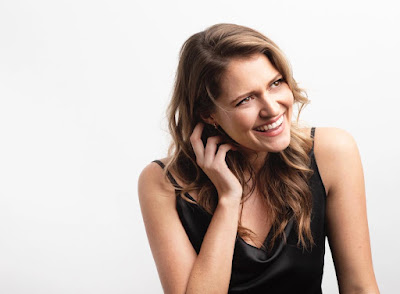 |
| Samantha Clarke (Photo: Benjamin Ealovega) |
Mozart in 1774 – Mozart: Symphonies Nos. 28 & 30, Bassoon Concerto, music from La finta giardiniera, music from Paisiello’s Andromeda; Samantha Clarke, Jane Gower, The Mozartists, Ian Page; Wigmore Hall
Reviewed 2 May 2024
Ian Page and his ensemble explore the symphonic music Mozart wrote in 1774, along with a superb contribution from bassoonist Jane Gower and soprano Samantha Clarke in outstanding form
In 1773, Mozart returned from his long journey to Italy and for the next four years was based in Salzburg. The new Archbishop took the view that at 17, Mozart was old enough to pull his weight in the court music and not go gadding about. There were trips, however, to Vienna and to Munich, this latter for the premiere of his opera La finta giardiniera. Mozart would, in time, become discontent with the limitations of artistic life at the Salzburg court, but whilst he explored what avenues it could give him. This means that he wrote in a wide variety of genres, including writing concertos for friends. But much of 1774 seems to have been devoted to symphonies, then in 1775 it was violin concertos with piano concertos in 1776 (all rather Schumann-esque in a way).
Ian Page and The Mozartists‘ Mozart 250 project has, this year, reached 1774. They have already given us a survey of the music Mozart might have heard that year, and they returned to Wigmore Hall on Thursday 2 May 2024 for a concert centring on music that Mozart wrote that year including Symphonies Nos. 28 and 30, the Bassoon Concerto with soloist Jane Gower, and a scene from La finta giardiniera with soprano Samantha Clarke, who also sang a scene from Paisiello’s Andromeda.
Mozart’s symphonies from 1774 are the subject of some discussion. Between 13 March 1773 (when he arrived back in Salzburg) and the end of 1774, Mozart write nine symphonies which his Father later bound together as symphonies nos. 22 to 30. At some time later, Mozart’s dates on them were catastrophically obliterated (possibly so that Mozart’s widow could sell them as more recent works) and commentators still discuss the exact dating order, mainly because they want to hear Mozart’s development in them. But in fact, these are works where youthful engagement and exuberance often bubble up.
They are still relatively small-scale, compact works. The Mozartists performed with 12 strings, double woodwind, horns and trumpets, making the music feel like extended chamber music, but it is clear that as the composer gets older and his ambitions develop (his next symphonies will be the Paris symphonies from 1778 in 2028), The Mozartists’ venues will have to expand similarly.
We began with Symphony No. 28 in C major, scored for strings, oboes, horns and trumpets. The first movement alternated brisk gestures and crisp detail, with hints of Sturm und Drang in the development. There was a lyrical elegance to the slow movement, but with quite busy movement underneath and a striking use of the horns to change the atmosphere in the transition to the trio. The minuet was full of character, and more horns, with a quietly quirky trio, then there was lots of furious scurrying in the fast and furious finale.
Paisiello wrote his opera Andromeda for the Teatro Regio Ducale in 1774, where Mozart’s Lucio Silla had premiered in 1773. Andromeda used a pre-existing libretto by the man who wrote the libretto for Mozart’s Mitridate, re di Ponto (written for Milan in 1770). We heard a scene where Andromeda thinks that Perseus has killed himself, and Mozart would set the text in 1777 in a concert aria, though he probably didn’t know Paisiello’s opera.
After a short, elegant orchestral introduction there was an accompanied recitative that was both expressive and dramatic, leading into an urgent aria where Andromeda upbraids the man who brings her the news about Perseus. Another accompanied recitative led into a lyrical, elegant second aria. What was striking was the way Paisiello developed a continuum between recitative and aria, rather than differentiating between them. Throughout Samantha Clarke was outstanding, with stylish and wonderfully engaged singing.
Mozart seems to have written (or at least begun) some five bassoon concertos, but only the Bassoon Concerto in B flat survives, probably written for one of the Salzburg court bassoonists. The bassoon of this period is a not uncomplex instrument to play, and like the horn of the same period, a feature is the wide range of tone colours depending on the note being played. Something Mozart uses to perfection, and throughout the concerto we noticed the wonderful range of colours Jane Gower brought to the piece, as well as her deft way with the showier passages. Yes, the concerto mined the instruments more comic, sometimes farty, elements, but Gower remained a demure and stylish soloist.
After the busy first movement, where we got to admire the instruments fruity tone, the slow movement was graceful and warm with some lovely singing tone from the soloist. Then there was a nice swagger to the final, along with some deftly vigorous divisions and playing full of character.
After the interval we began with Mozart’s Epistle Sonata No. 4 in Major, a single-movement, characterful and vigorous piece intended for use in church. Then came Sandrina’s scene from the end of Act Two of La finta giardiniera where she has been abandoned in a cave. We began with an intense aria with Clarke’s plangent tone supported by throbbing wind, then seamlessly into an accompanied recitative before the final aria with Clarke urgent and intent.
The formal programme finished with another symphony, No. 30 this time. The opening movement all crisp vigour with lots of instrumental colour, then a dance-like slow movement with some lovely detail. The robust minuet had a trio full of different moving parts and finally a joyfully exuberant finale where Mozart’s youth was all apparent.
This concert gave us a fascinating insight into the artistic and emotional development of the composer. For me the symphonies were charming character pieces whilst the concerto showed remarkable prescience in the handling of the tricky solo instrument, but it was in the arias from La finata giardiniera that we felt the mature Mozart appearing. It helped that as an encore, Samantha Clarke and the ensemble gave us a further, moving aria. Samantha Clarke was outstanding throughout and I look forward to hearing her again. We caught her last year as Fiordiligi in Cosi fan tutte at the Grange Festival [see my review] and she is making her role debut as the Countess in Le nozze di Figaro at Garsington Opera this Summer.
Never miss out on future posts by following us
The blog is free, but I’d be delighted if you were to show your appreciation by buying me a coffee.
Elsewhere on this blog
- Vigour, energy & joy: A Choral Celebration of Queen Mary II from choirs of Royal Hospital Chelsea & Old Royal Naval College – concert review
- A neglected gem revived: New Sussex Opera in Lampe’s The Dragon of Wantley combining historic style and 1980s politics – opera review
- Lobesgesang: Mendelssohn’s rarely performed symphony-cantata is a fine climax to Sir Andras Schiff and the OAE’s exploration of the composer’s symphonic music – concert review
- Fear no more: Brindley Sherratt on releasing his first recital disc – interview
- A German in Venice: Schütz alongside music he could have heard in Venice, a wonderfully life-affirming disc – record review
- Attention must be paid: the Engegård Quartet at Conway Hall in Mozart, Bartok, Maja Ratkje, and Fanny Mendelssohn – concert review
- Opera as it ought to be: Mozart’s Don Giovanni from Hurn Court Opera reviewed by James McConnachie – opera review
- Leeds Lieder 2024
- A Leeds Songbook and a showcase performance: Leeds Lieder Young Artists 2024 – concert review
- A day of French song with a focus on Fauré, with Graham Johnson making us love the composer’s late period, and James Gilchrist in fine form – concert review
- Engaging the audience: James Newby and Joseph Middleton in a folk-inspired programme at a cool Leeds café/bar – concert review
- The sound of an image: recent chamber music by New York City-based, Puerto Rican-born composer Gabriel Vicéns – record review
- A City Full of Stories: Anna Phillips on her work with Academy of St Martin in the Fields’ SoundWalk – guest posting
- Energy, discipline, & sheer love of music-making: National Youth Orchestra & National Youth Brass Band in Gavin Higgins – concert review
- Home





.jpg?w=670&resize=670,446&ssl=1)


